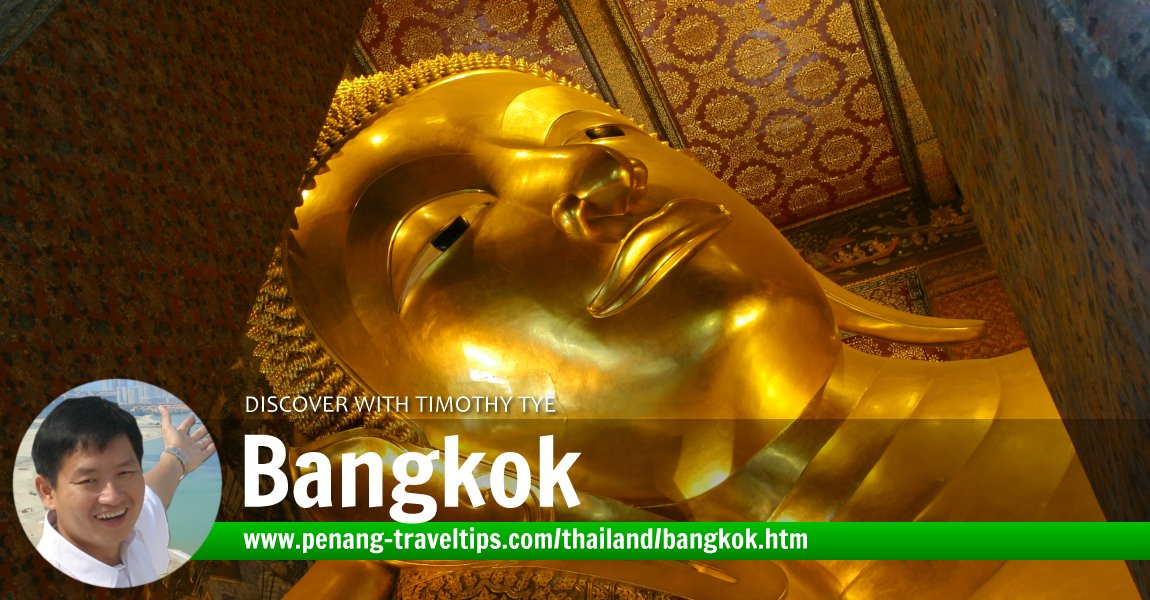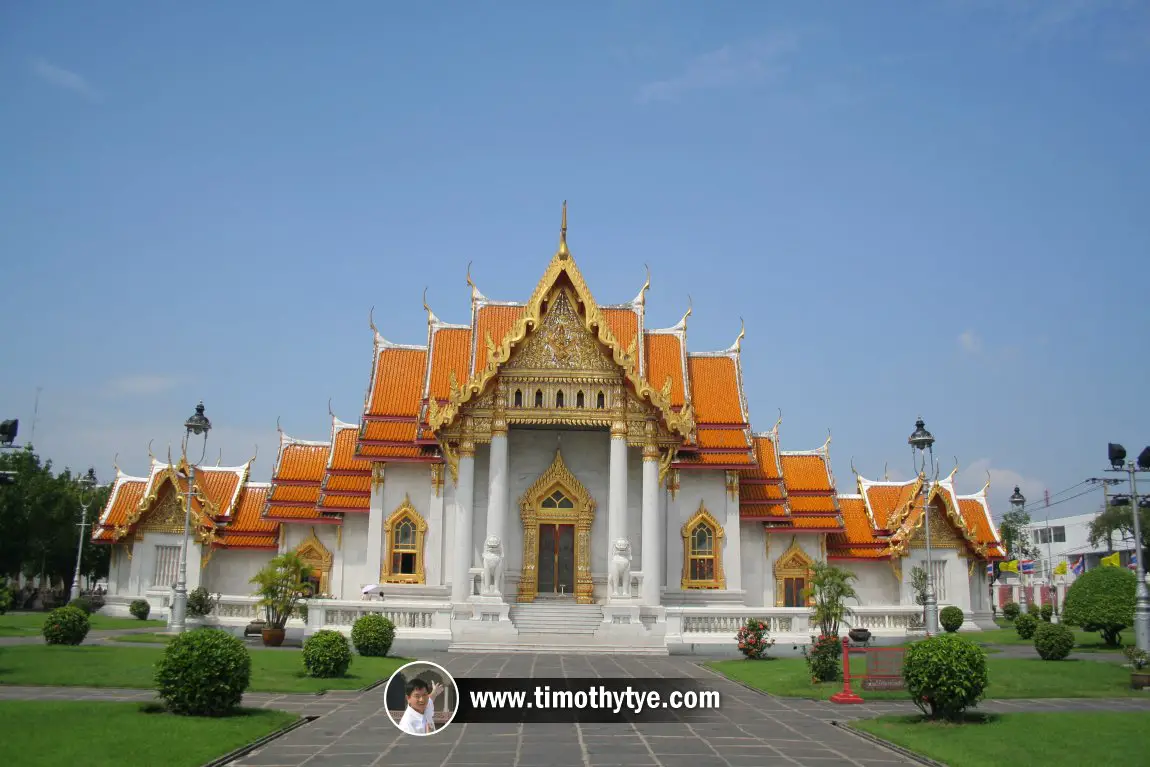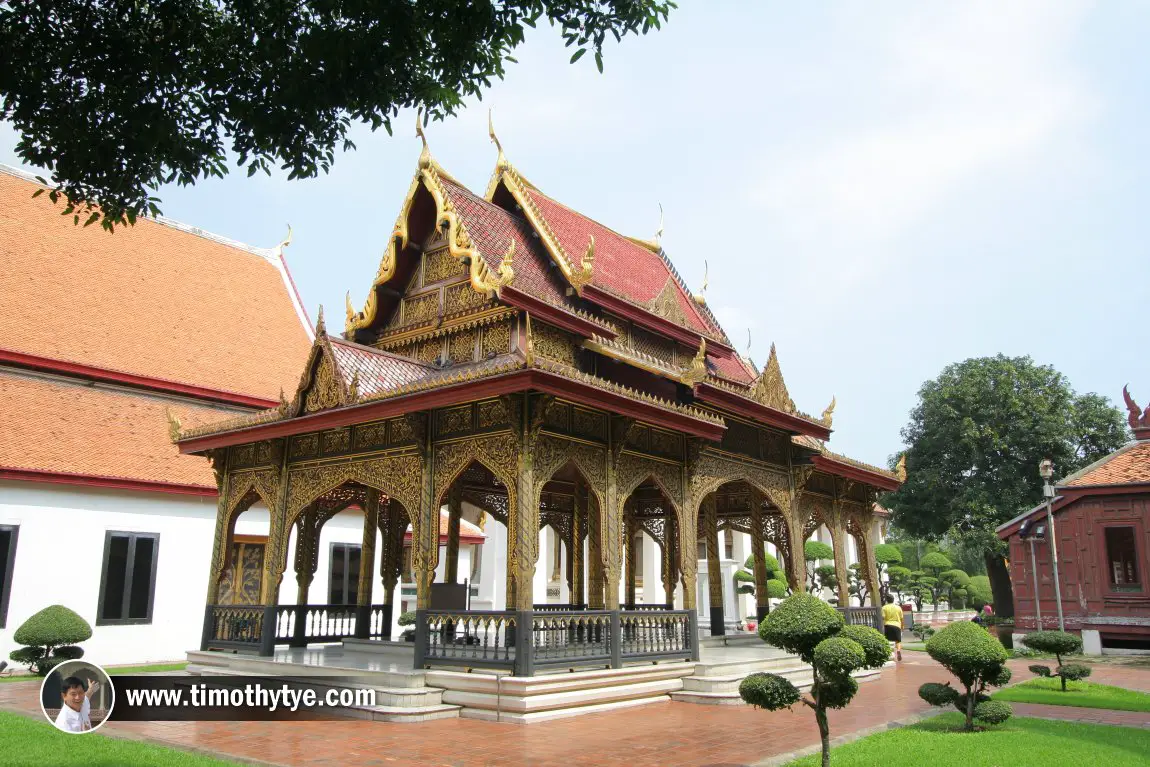
 Bangkok (28 October, 2006)
Bangkok (28 October, 2006)
B. Melayu
Bangkok provides you tips to help you get to know and plan your visit to Bangkok กรุงเทพ
 , the capital and biggest city in Thailand. It is one of the most exciting travel destinations in Asia, with a lot of tourist attractions located within and near to it. The city is rich in culture and history. Architecture-wise, Bangkok is an amalgam of the old and the new, with ramshackled structures next to gleaming skyscrapers and serene wats, as the Thai temples are called.
, the capital and biggest city in Thailand. It is one of the most exciting travel destinations in Asia, with a lot of tourist attractions located within and near to it. The city is rich in culture and history. Architecture-wise, Bangkok is an amalgam of the old and the new, with ramshackled structures next to gleaming skyscrapers and serene wats, as the Thai temples are called.There are numerous temples in the city, and to the untrained eyes, they all look more or less the same. In addition to the ubiquitous temples, Bangkok also has quite a number of mosques, churches and even Hindu temples. The most famous temples in Bangkok are the Temple of the Emerald Buddha, the Temple of the Reclining Buddha, and the Temple of Dawn.
Map of the major sights in Bangkok
What to eat in Bangkok
- Thai Street Food in front of CentralWorld, in Bangkok, Thailand, was recommended by Ooichinchye Chinchye, 23 August, 2019
Sights in Bangkok
- Baiyoke Tower II (GPS: 13.75416, 100.54055)

- Chatuchak Weekend Market (GPS: 13.79924, 100.54846)

- Giant Swing (GPS: 13.75189, 100.50114)

- Grand Palace (GPS: 13.75219, 100.49119)

- Hua Lamphong Railway Station (GPS: 13.73881, 100.51658)

- Jim Thompson House (GPS: 13.74912, 100.52838)

- Wat Arun (Temple of Dawn) (GPS: 13.7437, 100.48892)

- Wat Phra Chetuphon (Temple of the Reclining Buddha) (GPS: 13.74657, 100.49315)

- Wat Phra Kaew (Temple of the Emerald Buddha) (GPS: 13.7516, 100.4926)

- Wat Suthat (GPS: 13.7515, 100.5011)

- Wat Traimit (GPS: 13.73756, 100.5136)

Other sights in Bangkok
- 200th Anniversary Clock Tower (GPS: 13.74664, 100.49445)

- Bangkok City Hall (GPS: 13.75381, 100.50182)

- Church of the Immaculate Conception (GPS: 13.77691, 100.5037)

- Giant Swing (GPS: 13.75189, 100.50114)

- National Stadium (GPS: 13.74674, 100.52594)

- Phu Khao Thong (The Golden Mount) (GPS: 13.75387, 100.50658)

- Siam Center (GPS: 13.74628, 100.53279)

- Siam Paragon (GPS: 13.7461, 100.53411)

- St Francis Xavier Church (GPS: 13.77797, 100.50493)

- Wat Maha Phruttharam (GPS: 13.73291, 100.51586)

- Wat Pathum Wanaram (GPS: 13.7459, 100.53674)

- Wat Saket (GPS: 13.75391, 100.50843)

Streets in Bangkok
Categories of sights in Bangkok
- PLACES IN BANGKOK
- Airports in Bangkok
- Buddhist Temples in Bangkok
- Bridges in Bangkok
- Canals in Bangkok
- Churches in Bangkok
- Historic Buildings in Bangkok
- Hospitals in Bangkok
- Markets in Bangkok
- Mass Transit System in Bangkok
- Monuments in Bangkok
- Museums in Bangkok
- Palaces in Bangkok
- Parks in Bangkok
- Rivers in Bangkok
- Shopping Malls in Bangkok
- Skyscrapers in Bangkok
- Stadiums in Bangkok
- Streets in Bangkok
- Subway Stations in Bangkok
- Train Stations in Bangkok
- Transport Terminals in Bangkok
- Waterways in Bangkok
Transportation in Bangkok
Places in Bangkok
 Wat Benchamabophit, Bangkok (27 October, 2006)
Wat Benchamabophit, Bangkok (27 October, 2006)
Introducing Bangkok
Visitors who love to shop will find Bangkok to be a true delight. Prices here is usually much lower than at other Asian capitals, though one of the highest within Thailand itself. For branded stuff, the place to go is Pathum Wan, in downtown Bangkok. This is where you can shop till you drop in the numerous air-conditioned malls such as Siam Paragon and Central World Plaza. For the more economical class type of shopping, nothing compares to Chatuchak Weekend Market, touted as the biggest open-air market in the world.A brief history of Bangkok
Originally Bangkok was developed on the western bank of the Chao Phraya River. The name Bangkok, which means "village of wild plums" refers to the area in Thonburi where the city was originally located.When King Rama I moved the capital across the river in 1782, to present-day Rattanakosin, the name "Bangkok" continued to be used by the foreign merchants, and became the official English name of the city.
Among the Thais, however, Bangkok is known as Krung Thep Maha Nakhon (written as กรุงเทพมหานคร and pronounced as
 . Most of the time, the people simply say Krung Thep (กรุงเทพ
. Most of the time, the people simply say Krung Thep (กรุงเทพ  ).
).There is however a longer official name for the city, which is Krungthepmahanakhon Amonrattanakosin Mahintharayutthaya Mahadilokphop Noppharatratchathaniburirom Udomratchaniwetmahasathan Amonphimanawatansathit Sakkathattiyawitsanukamprasit.
This is written in Thai like this, กรุงเทพมหานคร อมรรัตนโกสินทร์ มหินทรายุธยา มหาดิลกภพ นพรัตนราชธานีบูรีรมย์ อุดมราชนิเวศน์มหาสถาน อมรพิมานอวตารสถิต สักกะทัตติยวิษณุกรรมประสิทธิ์, and you read it as
 . This massive mouthful, translated into English, goes something like this: City of Angels, Great City of the Immortals, Magnificent City of Nine Gems, Seat of the King, City of Royal Palaces, Home of the Gods Incarnate, Erected by Visvakarman at Indra's Behest. There.
. This massive mouthful, translated into English, goes something like this: City of Angels, Great City of the Immortals, Magnificent City of Nine Gems, Seat of the King, City of Royal Palaces, Home of the Gods Incarnate, Erected by Visvakarman at Indra's Behest. There.Today Bangkok and its metropolitan area has a total population of 15 million people, making it far and ahead the biggest city in Thailand. The urban area of Bangkok has sprawled across both sides of the Chao Phraya. It is a haphazardly developed city that is notorious for its traffic congestion. The construction of several elevated expressways that make sweeping loops across the metropolis has done much to reduce the infamous crawls, though it is not entirely eliminated. Often, once you reach the exit ramps of the expressway, you come to a grinding halt.
In addition to the elevated expressways, Bangkok also has a network of mass transit trains. They include the elevated system, called the BTS Skytrain, and a subway system, called the Bangkok Metro. The Skytrain, in service since December 5, 1999, has 22 stations covering 23.5km, with plans for extensions on the map. The Metro, after several delays, was finally opened on April 13, 2004, with the Hua Lamphong - Bang Sue Route of 18 stations covering 20km. The two systems have interchanges at Silom/Saladaeng, Sukhumvit/Asok and Chatuchak/Mo Chit.
 Pavilion at National Museum, Bangkok (28 October, 2006)
Pavilion at National Museum, Bangkok (28 October, 2006)
Getting to Bangkok by Plane via Suvarnabhumi Airport
Suvarnabhumi Airport is the main gateway to Bangkok and Thailand. This ultra-modern airport is located 30 km to the east of the city centre. There are a number of airlines operating cheap flights to Bangkok from Southeast Asia, Europe, Australia and other parts of the world, making it easier and cheaper than ever before to vacation in Bangkok.From Suvarnabhumi Airport, you can take a metered taxi to Bangkok. The taxi stand is on the 1st floor. Join the queue and state your destination to the taxi desk. Your destination will be written on a two-part slip. Your taxi driver will take the smaller portion. You hold on to the larger portion as your receipt. Use if should there arise a need to complain. There is a 50-baht surcharge per taxi on top of the meter charge and toll. Expect to pay between 250-400 baht taxi fare and another 25 baht for toll. The journey should take around 4 5-60 minutes.
Avoid paying a flat rate for your taxi trip. You will usually pay more on a flat rate.
Getting to Bangkok By Plane via Don Muang Airport
The old international airport at Don Muang is now used by two domestic Thai airlines, Nok Air and One-Two-GO serving domestic destinations. If you happen to arrive at Don Muang, you can take the taxi at the public taxi stand located at the sidewalk just outside the Arrivals area. Ignore all the taxi service booths located in the mainhall. Here, at the sidewalk, you find the taxi stand similar to the one at Suvarnabhumi Airport.Taking the Skytrain
The Skytrain is the elevated light rail transit system. Fares range from 15 to 40 baht and have to be bought at the machines. If you are staying for a few days, you may buy the stored-value card (travel value from 100 baht, plus a 30 baht refundable deposit and another 30 baht non-refundable cost) or the tourist unlimited ride card (from 120 baht per day).Presently the Skytrain comprises two lines, the green Sukhumvit Line, and the red Silom Line. They interchange at the station at Siam Square.
Taking the Metro
The Bangkok Metro is the subway that presently has only one route, the Blue Line, which runs from Hualamphong Railway Station to Bang Sue Station. It interchanges with the Skytrain at Silom/Sala Daeng, Sukhumvit/Asok and Chatuchak/Mo Chit. The fare starts from 15 baht. A round plastic token is used as the ticket.Taking the Chao Phraya Express Boat
Board at piers and pay the ticket collector. The fare is 13 baht for the basic service, which stops at every pier. In addition, there is the "express boat" with yellow or orange flags. These only stop at selected piers, and should be avoided unless you know exactly where you are going.
Taking the Taxi
The taxi is a clean, comfortable way to get around Bangkok. But it isn't exactly the fastest, as you may get trapped in a jam. Nonetheless it does take you right to the doorstep of your destination. The flag-down fare is 35 baht. Most trips will cost you less than 100 baht. Be sure that the driver "remembers" to turn on the meter - it will show a digital 35 on the dashboard. Taxis in Bangkok are some of the most brightly painted vehicles anywhere.Warning: Beware of taxi or tuk tuk drivers that offer rides to discount Jewelry stores or entertainment venues. You may end up buying fake goods or be led into some form of scam or deception. Firmly decline if approached, and report such incidences to the Thai Tourist Police at 1155.
Taking the Tuk Tuk
I personally do not recommend taking the tuk-tuk in Bangkok - though for smaller cities such as Chiang Mai, that would be the preferred option. The reason is that, it is too dusty to ride in a tuk tuk. Unlike the taxi, with broad windows, you don't get to see exactly where you are going, and on top of it all, it is not any cheaper than taking the taxi.Bangkok Road Network
Bangkok is the nerve centre for Thailand's road system. Traditionally, there are four major highways that radiate out of Bangkok - Phahonyothin Road (Route 1) going north; Mittraphap Road (Route 2) going from Saraburi (outside Bangkok) at a juntion of Phahonyothin Road, to Nong Khai in the northeast; Sukhumvit Road (Route 3) extending from Rama I road in Bangkok until Khlong Yai District in Trat Province, at the border with Cambodia; and Phet Kasem Road (Route 4) from the Naowa Chamnian Bridge in Bangkok Yai, to Sadao in Songkhla Province, where it connects with Malaysia's North-South Expressway at Bukit Kayu Hitam, Kedah. Latest updates on Penang Travel Tips
Latest updates on Penang Travel Tips
 Map of Roads in Penang
Map of Roads in Penang
Looking for information on Penang? Use this Map of Roads in Penang to zoom in on information about Penang, brought to you road by road.About this website

Dear visitor, thank you so much for reading this page. My name is Timothy Tye and my hobby is to find out about places, write about them and share the information with you on this website. I have been writing this site since 5 January 2003. Originally (from 2003 until 2009, the site was called AsiaExplorers. I changed the name to Penang Travel Tips in 2009, even though I describe more than just Penang but everywhere I go (I often need to tell people that "Penang Travel Tips" is not just information about Penang, but information written in Penang), especially places in Malaysia and Singapore, and in all the years since 2003, I have described over 20,000 places.
While I try my best to provide you information as accurate as I can get it to be, I do apologize for any errors and for outdated information which I am unaware. Nevertheless, I hope that what I have described here will be useful to you.
To get to know me better, do follow me on Facebook!
Copyright © 2003-2025 Timothy Tye. All Rights Reserved.


 Go Back
Go Back